| Article ID | Journal | Published Year | Pages | File Type |
|---|---|---|---|---|
| 2920832 | Heart, Lung and Circulation | 2010 | 9 Pages |
BackgroundIschaemic Heart Disease (IHD) is a leading cause of death in New Zealand and the burden falls disproportionately on Māori, the indigenous population of Aotearoa New Zealand.MethodsData for Māori:non-Māori disparities in risk factors, hospitalisation, procedure receipt and mortality for IHD are analysed. Age-adjusted rates of IHD mortality (2000–2004) and publicly funded hospitalisations and procedures (2003–2005) for Māori and non-Māori are reported and compared.ResultsSignificant inequalities between Māori and non-Māori in IHD risk factors, hospitalisations, mortality and the receipt of related procedures exist. IHD hospitalisation rates for Māori are 1.4 times that of non-Māori, however mortality rates are more than twice that of non-Māori. In recent years Māori revascularisation rates have increased (as have non-Māori rates) but are still considerably less than might be expected given the much higher mortality rates.ConclusionDespite high need, Māori receive relatively low access to appropriate care for IHD. The role of society, policy, and the clinician are three key factors to be considered in reducing inequalities for IHD between Māori and non-Māori.
